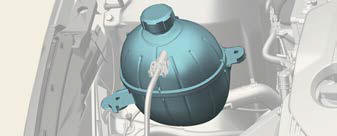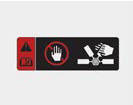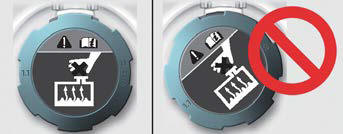Kia Sportage: Checking the coolant level
The high-pressure cooling system has a reservoir filled with year round antifreeze coolant. The reservoir is filled at the factory.
Check the antifreeze protection and coolant level at least once a year, at the beginning of the winter season, and before traveling to a colder climate.
CAUTION
- When the engine overheats from low engine coolant, suddenly adding engine coolant may cause cracks in the engine. To prevent damage, add engine coolant slowly in small quantities.
- Do not drive with no engine coolant. It may cause water pump failure and engine seizure, etc.
Checking the coolant level

Check the condition and connections of all cooling system hoses and heater hoses. Replace any swollen or deteriorated hoses.
The coolant level should be filled between the MAX and the MIN marks on the side of the coolant reservoir when the engine is cool.
If frequent additions are required, have the system inspected by an authorized Kia dealer.
CAUTION
 Removing engine
coolant reservoir cap
Removing engine
coolant reservoir cap
Never attempt to remove the engine coolant reservoir cap while the engine is operating or hot.
Doing so might lead to cooling system and engine damage. Also, hot coolant or steam could cause serious personal injury.
Turn the engine off and wait until it cools down. Use extreme care when removing the engine coolant reservoir cap. Wrap a thick towel around it, and turn it counterclockwise slowly to the first stop. Step back while the pressure is released from the cooling system.
When you are sure all the pressure has been released, press down on the cap, using a thick towel, and continue turning counterclockwise to remove it.
Even if the engine is not operating, do not remove the engine coolant reservoir cap or the drain plug while the engine and radiator are hot. Hot coolant and steam may still blow out under pressure, causing serious injury.
WARNING
 The
electric motor
(cooling fan) is controlled
by engine coolant
temperature,
refrigerant pressure
and vehicle speed. It
may sometimes operate even when the
engine is not running. Use extreme caution
when working near the blades of
the cooling fan so that you are not
injured by a rotating fan blades. As the
engine coolant temperature decreases, the electric motor will automatically shut
off. This is a normal condition.
The
electric motor
(cooling fan) is controlled
by engine coolant
temperature,
refrigerant pressure
and vehicle speed. It
may sometimes operate even when the
engine is not running. Use extreme caution
when working near the blades of
the cooling fan so that you are not
injured by a rotating fan blades. As the
engine coolant temperature decreases, the electric motor will automatically shut
off. This is a normal condition.
The electric motor (cooling fan) may operate until you disconnect the negative battery cable.
Check the condition and connections of all cooling system hoses and heater hoses. Replace any swollen or deteriorated hoses.
The coolant level should be filled between MAX and MIN (F and L) marks on the side of the coolant reservoir when the engine is cool.
If the coolant level is low, add enough distilled (deionized) or soft water. Bring the level to MAX (F), but do not overfill.
If frequent additions are required, have the system inspected by an authorized Kia dealer.
NOTICE
Make sure the coolant cap is properly closed after refill of coolant. Otherwise the engine could be overheated while driving.
- Check if the engine coolant reservoir cap label is straight In front.

- Make sure that the tiny protrusions inside the coolant cap are securely interlocked.
READ NEXT:
 Recommended engine coolant
Recommended engine coolant
When adding coolant, use only deionized
water or soft water for your vehicle
and never mix hard water in the
coolant filled at the factory. An
improper coolant mixture can result in
serio
 Brake fluid
Brake fluid
Checking the brake fluid level
Check the fluid level in the reservoir
periodically. The fluid level should be
between MAX and MIN marks on the
side of the reservoir.
Before removing the re
 Washer fluid
Washer fluid
Checking the washer fluid level
The reservoir is translucent so that you
can check the level with a quick visual
inspection.
Check the fluid level in the washer
fluid reservoir and add fl
SEE MORE:
 Intake Actuator
Intake Actuator
Components and Components
Location
Component Location
Description and Operation
Description
1. The intake actuator is located at the blower unit.
2. It regulates the intake door by signal from control unit.
3. Pressing the intake selection switch will shift between recirculation a
 Blind-Spot Collision-Avoidance Assist malfunction and
limitations
Blind-Spot Collision-Avoidance Assist malfunction and
limitations
Check Blind-Spot Safety system
When Blind-Spot Collision-Avoidance
Assist is not working properly, the warning message will appear on the cluster
for several seconds, and the master
warning light ( ) will appear. Have
Blind-Spot Collision-Avoidance Assist be
inspected by an authorized
Content
- Home
- Kia Sportage - Fifth generation (NQ5) - (2022-2025) - Owner's Manual
- Kia Sportage - Second generation (JEKM) (2005-2015) - Body Workshop Manual
- Kia Sportage Third generation (SL) - (2011-2016) - Service and Repair Manual
- Sitemap
- Top articles